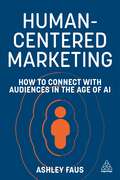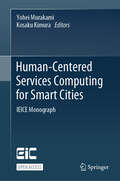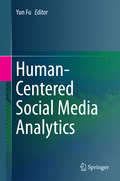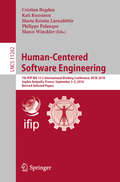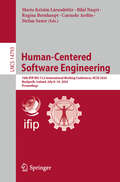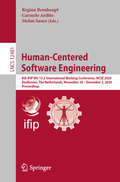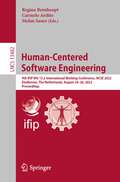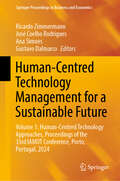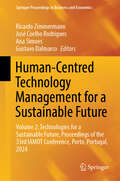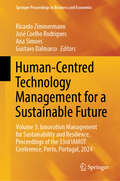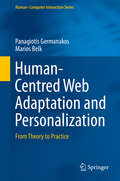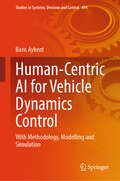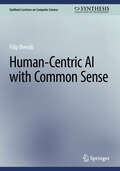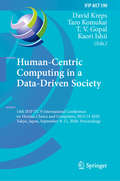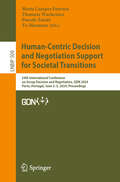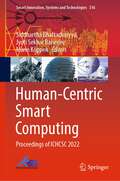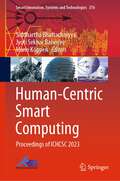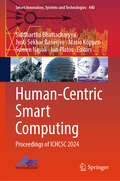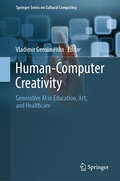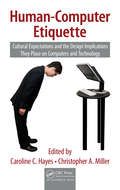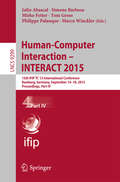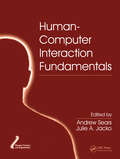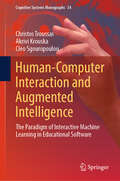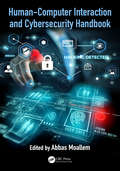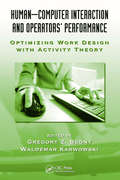- Table View
- List View
Human-Centered Marketing: How to Connect with Audiences in the Age of AI
by Ashley FausWith the rise of AI, excess of distribution channels, and focus on tracking every touchpoint in order to drive revenue, consumer trust is at an all-time low. To restore trust, brands need to create delightful, seamless, and impactful journeys to connect with the humans behind the screen.Human-Centered Marketing introduces three frameworks to help mid-senior-level marketers find, connect with, and convert audiences. The book helps you map an audience journey that behaves like a playground instead of a linear funnel, evolve the approach to social media to go beyond conversations and instead facilitate and engage with the community and build thought leaders, to build trust and move your audience into the future.Each chapter includes practical advice to help seasoned marketers shift their strategy and offers tactical implementation recommendations. All chapters include real-world examples from companies like Adobe, Hubspot, and Edelman to demonstrate that this shift from the standard playbook actually works.
Human-Centered Services Computing for Smart Cities: IEICE Monograph
by Yohei Murakami Kosaku KimuraThis open-access book compiles seven monographs from researchers at the forefront of services computing and artificial intelligence for smart cities. This is structured into three thematic parts: service composition, big data analysis, and service integration for smart cities.The first part describes service compositions for smart cities, where interaction between services and the physical world, including humans, is paramount, unlike services on the Web and clouds. The second part addresses the challenges of big data analytics in smart cities, with a focus on privacy-preserving methodologies. The third part reports human-centered service integration for applications in smart cities.
Human-Centered Social Media Analytics
by Yun FuThis book provides a timely and unique survey of next-generation social computational methodologies. The text explains the fundamentals of this field, and describes state-of-the-art methods for inferring social status, relationships, preferences, intentions, personalities, needs, and lifestyles from human information in unconstrained visual data. Topics and features: includes perspectives from an international and interdisciplinary selection of pre-eminent authorities; presents balanced coverage of both detailed theoretical analysis and real-world applications; examines social relationships in human-centered media for the development of socially-aware video, location-based, and multimedia applications; reviews techniques for recognizing the social roles played by people in an event, and for classifying human-object interaction activities; discusses the prediction and recognition of human attributes via social media analytics, including social relationships, facial age and beauty, and occupation.
Human-Centered Software Engineering (Lecture Notes in Computer Science #8742)
by Cristian Bogdan Marco Winckler Philippe Palanque Kati Kuusinen Marta Kristín LárusdóttirThis book constitutes the refereed post-conference proceedings of the 7th IFIP WG 13.2 International Conference on Human-Centered Software Engineering, HCSE 2018, held in Sophia Antipolis, France, in September 2018. The 11 full papers and 7 short papers presented together with 5 poster and demo papers were carefully reviewed and selected from 36 submissions. The papers focus on the interdependencies between user interface properties and contribute to the development of theories, methods, tools and approaches for dealing with multiple properties that should be taken into account when developing interactive systems. They are organized in the following topical sections: HCI education and training; model-based and model-driven approaches; task modeling and task-based approaches; tools and tool support; and usability evaluation and UI testing.
Human-Centered Software Engineering: 10th IFIP WG 13.2 International Working Conference, HCSE 2024, Reykjavik, Iceland, July 8–10, 2024, Proceedings (Lecture Notes in Computer Science #14793)
by Regina Bernhaupt Stefan Sauer Marta Kristín Lárusdóttir Bilal Naqvi Carmelo ArditoThis book constitutes the refereed proceedings of the 10th IFIP WG 13.2 International Working Conference on Human-Centered Software Engineering, HCSE 2024, held in Reykjavik, Finland, during Iceland, July 8–10, 2024. The 11 full papers with 5 poster, 4 demos and 3 PhD forum papers were carefully selected from 36 submissions. HCSE 2024 conference and papers focused on recurring topics such as innovative methods for human-centered and participatory design and software engineering, modeling approaches, usable security, and the balancing of multiple properties in the development, but also on emerging areas like immersive environments and augmented/virtual/mixed reality, low-code development and human-centered AI.
Human-Centered Software Engineering: 8th IFIP WG 13.2 International Working Conference, HCSE 2020, Eindhoven, The Netherlands, November 30 – December 2, 2020, Proceedings (Lecture Notes in Computer Science #12481)
by Regina Bernhaupt Stefan Sauer Carmelo ArditoThis book constitutes the refereed conference proceedings of the 8th IFIP WG 13.2 International Conference on Human-Centered Software Engineering, HCSE 2020, which was supposed to be held in Eindhoven, The Netherlands, in November/December 2020, was instead held virtually due to the COVID-19 pandemic.The 10 full papers and 5 short poster and demo papers presented together with 5 poster and demo papers were carefully reviewed and selected from 33 submissions. The papers focus on the interdependencies between user interface properties and contribute to the development of theories, methods, tools and approaches for dealing with multiple properties that should be taken into account when developing interactive systems. They are organized in the following topical sections: user-centred design approaches; model-based and model-driven approaches; software development strategies; and posters and demos.
Human-Centered Software Engineering: 9th IFIP WG 13.2 International Working Conference, HCSE 2022, Eindhoven, The Netherlands, August 24–26, 2022, Proceedings (Lecture Notes in Computer Science #13482)
by Regina Bernhaupt Stefan Sauer Carmelo ArditoThis book constitutes the refereed conference proceedings of the 9th IFIP WG 13.2 International Conference on Human-Centered Software Engineering, HCSE 2022, which was held in Eindhoven, The Netherlands, during August 2022. The 11 full papers presented together with 2 poster and demo papers were carefully reviewed and selected from 25 submissions. The papers focus on the interdependencies between user interface properties and contribute to the development of theories, methods, tools and approaches for dealing with multiple properties that should be taken into account when developing interactive systems. They are organized in the following topical sections: user-centred design approaches; model-based and model-driven approaches; software development strategies; and posters and demos.
Human-Centred Technology Management for a Sustainable Future: Volume 1: Human-Centred Technology Approaches, Proceedings of the 33rd IAMOT Conference, Porto, Portugal, 2024 (Springer Proceedings in Business and Economics)
by Gustavo Dalmarco Ricardo Zimmermann José Coelho Rodrigues Ana SimoesThis proceedings volume contains selected papers from the 33rd International Association for Management of Technology (IAMOT) Conference, held from July 8-11, 2024, in Porto, Portugal. It is the second volume of a three-volume set of conference proceedings focused on technologies for a sustainable future. The book explores the challenges and opportunities in today's social and business landscapes, delving into innovative and disruptive concepts. With a special emphasis on the role of technologies, it sheds light on how they enable novel approaches to address current issues. The volume demonstrates that, following the principles of Industry 5.0, technologies can go far beyond productivity and economic gains, contributing to the benefit and comfort of human workers. It also elucidates the necessity of adopting a human-centered approach in utilizing technology to adapt production processes to workers' needs, while ensuring that the implementation of new technologies does not infringe upon the fundamental rights of workers.
Human-Centred Technology Management for a Sustainable Future: Volume 2: Technologies for a Sustainable Future, Proceedings of the 33rd IAMOT Conference, Porto, Portugal, 2024 (Springer Proceedings in Business and Economics)
by Gustavo Dalmarco Ricardo Zimmermann José Coelho Rodrigues Ana SimoesThis proceedings volume contains selected papers from the 33rd International Association for Management of Technology (IAMOT) Conference, held from July 8-11, 2024, in Porto, Portugal. It is the second volume of a three-volume set of conference proceedings focused on technologies for a sustainable future. The book explores the challenges and opportunities in today's social and business landscapes, delving into innovative and disruptive concepts. With a special emphasis on the role of technologies, it sheds light on how they enable novel approaches to address current issues. The volume demonstrates that, following the principles of Industry 5.0, technologies can go far beyond productivity and economic gains, contributing to the benefit and comfort of human workers. It also elucidates the necessity of adopting a human-centered approach in utilizing technology to adapt production processes to workers' needs, while ensuring that the implementation of new technologies does not infringe upon the fundamental rights of workers.
Human-Centred Technology Management for a Sustainable Future: Volume 3: Innovation Management for Sustainability and Resilience, Proceedings of the 33rd IAMOT Conference, Porto, Portugal, 2024 (Springer Proceedings in Business and Economics)
by Gustavo Dalmarco Ricardo Zimmermann José Coelho Rodrigues Ana SimoesThis proceedings volume contains selected papers from the 33rd International Association for Management of Technology (IAMOT) Conference, held from July 8-11, 2024, in Porto, Portugal. It is the second volume of a three-volume set of conference proceedings focused on technologies for a sustainable future. The book explores the challenges and opportunities in today's social and business landscapes, delving into innovative and disruptive concepts. With a special emphasis on the role of technologies, it sheds light on how they enable novel approaches to address current issues. The volume demonstrates that, following the principles of Industry 5.0, technologies can go far beyond productivity and economic gains, contributing to the benefit and comfort of human workers. It also elucidates the necessity of adopting a human-centered approach in utilizing technology to adapt production processes to workers' needs, while ensuring that the implementation of new technologies does not infringe upon the fundamental rights of workers.
Human-Centred Web Adaptation and Personalization
by Panagiotis Germanakos Marios BelkThis book focuses on theimportance of adaptation and personalization in today's society and theupgraded role computational systems and the Internet play in our day-to-dayactivities. In this era of wireless communication, pervasive computing and the Internet of Things, it is becoming increasingly critical to ensure humans remain central in the developmental process of new technologies to guarantee their continued usefulness and a positive end-user experience. Organized into three clear parts - theory, principles and practice, a holistic approach to designing and developing adaptive interactive systems and services has been adopted. With an emphasis on distinct human factors, both basic and applied research topics are explored, extending from human-centred user models, driven by user's individual differences in cognitive processing and emotions, to the creation of smart interfaces that can handle the ever increasing volume and complexity of information to the benefit of the end-user. Human-Centred Web Adaptation and Personalization - From Theory to Practice is meticulously crafted to serve researchers, practitioners, and students who wish to have an end-to-end understanding of how to convert pure research and scientific results into viable user interfaces, system components and applications. It will serve to bridge the knowledge gap that still remains by suggesting interaction design and implementation guidelines for areas like E-Commerce, E-Learning and Usable Security.
Human-Centric AI for Vehicle Dynamics Control: With Methodology, Modelling and Simulation (Studies in Systems, Decision and Control #494)
by Baris AykentThis book approaches its subject matter by merging advanced AI techniques with traditional vehicle dynamics control. It emphasizes human-centric design to improve safety, comfort, and personalization in automotive systems like active front steering (AFS) and electronic stability control (ESC). What’s new is its focus on human-centric AI, integrating adaptive systems that anticipate driver intent and balance automation with user engagement. The book spans from basic vehicle dynamics to AI-powered methods, targeting engineers, researchers, and students. It’s key for designing, testing, and optimizing control systems while addressing future challenges in autonomous and connected vehicles.
Human-Centric AI with Common Sense (Synthesis Lectures on Computer Science)
by Filip IlievskiThis book enables readers to understand the challenges and opportunities of developing human-centered AI with commonsense reasoning abilities. Despite apparent accuracy improvements brought by large neural models across task benchmarks, common sense is still lacking. The lack of common sense affects many tasks, including story understanding, decision-making, and question answering. Commonsense knowledge and reasoning have long been considered the “black matter” of AI, raising concerns about the trustworthiness and applicability of AI methods in both autonomous and hybrid applications. This book describes how to design a more robust, collaborative, explainable, and responsible AI through incorporating neuro-symbolic commonsense reasoning. In addition, the book provides examples of how these properties of AI can facilitate a wide range of social-good applications in digital democracy, traffic monitoring, education, and robotics. What makes commonsense reasoning such a unique and impactful challenge? What can we learn from cognitive research when designing and developing AI systems? How can we approach building responsible, robust, collaborative, and explainable AI with common sense? And finally, what is the impact of this work on human-AI teaming? This book provides an accessible introduction and exploration of these topics.
Human-Centric Computing in a Data-Driven Society: 14th IFIP TC 9 International Conference on Human Choice and Computers, HCC14 2020, Tokyo, Japan, September 9–11, 2020, Proceedings (IFIP Advances in Information and Communication Technology #590)
by David Kreps T. V. Gopal Taro Komukai Kaori IshiiThis book constitutes the refereed proceedings of the 14th IFIP TC 9 International Conference on Human Choice and Computers, HCC14 2020, which was supposed take place in Tokyo, Japan, in September 2020, but the conference was cancelled due to the COVID-19 crisis.The 31 revised full papers presented were carefully reviewed and selected from 55 submissions. The papers deal with the constantly evolving intimate relationship between humans and technology. They are organized in the following sections: ethical and legal considerations in a data-driven society; the data-driven society; peace and war; our digital lives; individuals in data-driven society; and gender, diversity and ICT.
Human-Centric Decision and Negotiation Support for Societal Transitions: 24th International Conference on Group Decision and Negotiation, GDN 2024, Porto, Portugal, June 3–5, 2024, Proceedings (Lecture Notes in Business Information Processing #509)
by Pascale Zaraté Yu Maemura Marta Campos Ferreira Thomasz WachowiczThis book constitutes the refereed proceedings of the 24th International Conference on Group Decision and Negotiation, GDN 2024, which took place in Porto, Portugal, during June 2–5, 2024. The field of Group Decision and Negotiation focuses on decision processes with at least two participants and a common goal but conflicting individual goals. Research areas of Group Decision and Negotiation include electronic negotiations, experiments, the role of emotions in group decision and negotiations, preference elicitation and decision support for group decisions and negotiations, and conflict resolution principles. The 13 full papers presented in this volume were carefully reviewed and selected from 100 submissions. They were organized in the following topical sections: Conflict Resolution; Preference Modeling for Group Decision and Negotiation; Collaborative and Responsible Negotiation Support Systems and Studies.
Human-Centric Smart Computing: Proceedings of ICHCSC 2022 (Smart Innovation, Systems and Technologies #316)
by Mario Köppen Siddhartha Bhattacharyya Jyoti Sekhar BanerjeeThis book includes high-quality research papers presented at the First International Conference on Human-Centric Smart Computing (ICHCSC 2022), organized by the University of Engineering and Management, Jaipur, India, on 27–29 April 2022. The topics covered in the book are human-centric computing, hyper connectivity, and data science. The book presents innovative work by leading academics, researchers, and experts from industry.
Human-Centric Smart Computing: Proceedings of ICHCSC 2023 (Smart Innovation, Systems and Technologies #376)
by Mario Köppen Siddhartha Bhattacharyya Jyoti Sekhar BanerjeeThis book includes high-quality research papers presented at the Second International Conference on Human-Centric Smart Computing (ICHCSC 2023), organized by the University of Engineering and Management, Jaipur, India, on 5–6 July 2023 in New Delhi, India. The topics covered in the book are human-centric computing, hyper connectivity, and data science. The book presents innovative work by leading academics, researchers, and experts from industry.
Human-Centric Smart Computing: Proceedings of ICHCSC 2024 (Smart Innovation, Systems and Technologies #440)
by Mario Köppen Siddhartha Bhattacharyya Jan Platos Jyoti Sekhar Banerjee Somen NayakThis book includes high-quality research papers presented at the Third International Conference on Human-Centric Smart Computing (ICHCSC 2024), held in Jaipur, India, during July 25–26, 2024. The topics covered in the book are human-centric computing, hyperconnectivity, and data science. The book presents innovative work by leading academics, researchers, and experts from industry.
Human-Computer Creativity: Generative AI in Education, Art, and Healthcare (Springer Series on Cultural Computing)
by Vladimir GeroimenkoThis pioneering volume showcases how generative AI has evolved from a mere tool to a creative partner, transforming the boundaries of innovation and collaboration across various disciplines. With contributions from 53 global experts spanning 21 countries, this comprehensive resource explores the transformative impact of AI on education, art, and healthcare. It reveals how AI enhances learning experiences, fosters new artistic expressions, and revolutionises patient care and medical research. Organised into five thematic parts, the book offers a balanced mix of conceptual frameworks, case studies, and practical insights, providing readers with a thorough understanding of how human ingenuity and artificial intelligence intersect to solve problems, inspire creativity, and redefine industries. Whether you are an academic, practitioner, or inquisitive reader, this volume invites you to engage with the cutting-edge possibilities of generative AI and embrace the future of human-computer collaboration.
Human-Computer Etiquette: Cultural Expectations and the Design Implications They Place on Computers and Technology (Supply Chain Integration Modeling, Optimization and Application)
by Caroline C. Hayes Christopher A. MillerWritten by experts from various fields, this edited collection explores a wide range of issues pertaining to how computers evoke human social expectations. The book illustrates how socially acceptable conventions can strongly impact the effectiveness of human-computer interactions and how to consider such norms in the design of human-computer inter
Human-Computer Interaction - INTERACT 2015
by Tom Gross Marco Winckler Philippe Palanque Julio Abascal Simone Barbosa Mirko FetterThe four-volume set LNCS 9296-9299 constitutes the refereed proceedings of the 15th IFIP TC13 International Conference on Human-Computer Interaction, INTERACT 2015, held in Bamberg, Germany, in September 2015. The 41 papers included in the first volume are organized in topical sections on accessibility; accessible interfaces for blind people; accessible interfaces for older adults; affective HCI and emotions and motivational aspects; alternative input; alternative input devices for people with disabilities; interfaces for cognitive support; brain-computer interaction; cognitive factors.
Human-Computer Interaction Fundamentals (Human Factors and Ergonomics)
by Julie A. Jacko Andrew SearsHailed on first publication as a compendium of foundational principles and cutting-edge research, The Human-Computer Interaction Handbook has become the gold standard reference in this field. Derived from select chapters of this groundbreaking and authoritative resource, Human-Computer Interaction Fundamentals emphasizes emerging topics such as sen
Human-Computer Interaction and Augmented Intelligence: The Paradigm of Interactive Machine Learning in Educational Software (Cognitive Systems Monographs #34)
by Christos Troussas Akrivi Krouska Cleo SgouropoulouThis book explores the transformative roles of human-computer interaction (HCI) and augmented intelligence (AI) in shaping intelligent systems. HCI focuses on designing interactive systems that enhance human-technology relationships, while AI empowers users with adaptive, data-driven tools that complement decision-making. Together, these fields drive innovation, creating systems that are efficient, intuitive, and inclusive, addressing diverse user needs across various domains. Central to this work is the paradigm of interactive machine learning (IML), which builds on HCI and AI principles to create adaptive systems capable of evolving in real-time. The book highlights the application of IML in educational software, demonstrating how dynamic, personalized, and responsive learning environments can enhance student engagement and success. It provides detailed case studies and practical examples that showcase how IML aligns educational content, feedback, and interactions with learner behaviors and preferences. Additionally, it includes numerous Python code implementations and actionable design strategies, making these concepts accessible to practitioners and researchers alike. Key topics include leveraging cognitive and communication styles to shape adaptive systems, integrating learning models to enhance personalization, and addressing ethical considerations such as data privacy and algorithmic fairness. Readers will also discover discussions on creating personalized tutoring systems, collaborative platforms, and immersive environments that redefine educational technology. This book is a valuable resource for researchers, software developers, educators, instructional designers, and technologists at the intersection of human-computer interaction, augmented intelligence, and educational innovation. With its comprehensive framework and practical insights, it offers the tools to design adaptive, inclusive, and impactful learning systems for the future.
Human-Computer Interaction and Cybersecurity Handbook (Human Factors and Ergonomics)
by Abbas Moallem<P><P>Recipient of the SJSU San Jose State University Annual Author & Artist Awards 2019 <P><P>Recipient of the SJSU San Jose State University Annual Author & Artist Awards 2018 <P><P>Cybersecurity, or information technology security, focuses on protecting computers and data from criminal behavior. The understanding of human performance, capability, and behavior is one of the main areas that experts in cybersecurity focus on, both from a human–computer interaction point of view, and that of human factors. This handbook is a unique source of information from the human factors perspective that covers all topics related to the discipline. It includes new areas such as smart networking and devices, and will be a source of information for IT specialists, as well as other disciplines such as psychology, behavioral science, software engineering, and security management. <P><P>Features <li>Covers all areas of human–computer interaction and human factors in cybersecurity <li>Includes information for IT specialists, who often desire more knowledge about the human side of cybersecurity <li>Provides a reference for other disciplines such as psychology, behavioral science, software engineering, and security management <li>Offers a source of information for cybersecurity practitioners in government agencies and private enterprises <li>Presents new areas such as smart networking and devices
Human-Computer Interaction and Operators' Performance: Optimizing Work Design with Activity Theory
by Waldemar Karwowski Gregory Z. BednyA collection of works authored by leading scientists from the US and Russia, Human-Computer Interaction and Operators' Performance: Optimizing Work Design with Activity Theory describes applied and systemic-structural activity theory as it is used to study human-computer interaction, aviation, design, and training. Important from a theoretical and
